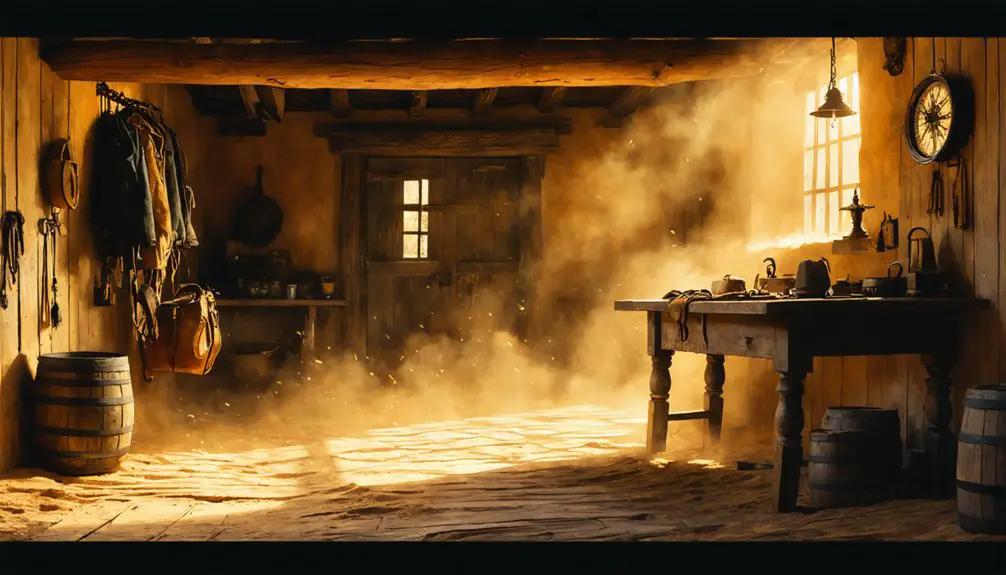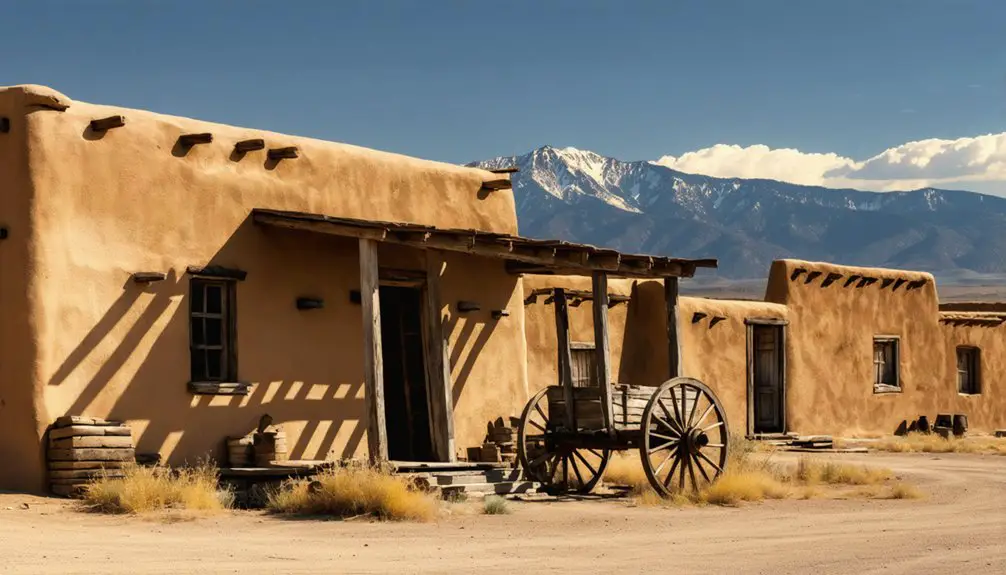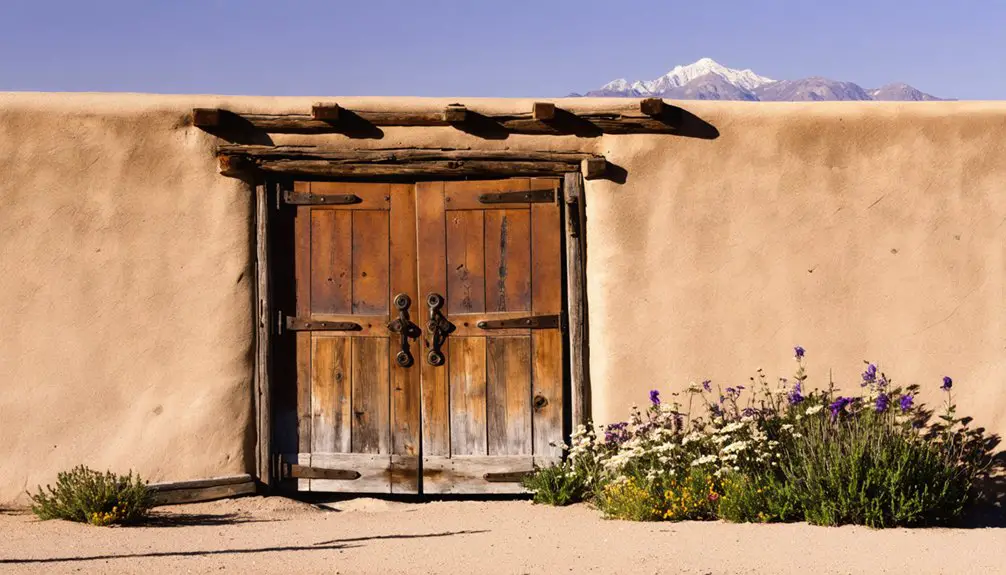You’ll discover Rayado, New Mexico as a ghost town established in 1848 at the intersection of the Santa Fe Trail‘s Mountain and Cimarron branches. Lucien Maxwell founded this essential frontier outpost, partnering with Kit Carson to develop it into a significant trade hub. The settlement’s archaeological remains reveal a complex history of commerce, cultural blending, and conflicts with Native Americans. The preserved structures and artifacts at Philmont Scout Ranch hold countless untold stories of frontier life.
Key Takeaways
- Rayado was established in 1848 by Lucien Maxwell at the intersection of major trading routes before becoming abandoned in the late 1800s.
- The settlement served as a crucial frontier trading post along the Santa Fe Trail before its decline and transformation into a ghost town.
- Archaeological remains and preserved structures like the 1859 Abreu ranch house offer glimpses into 19th-century frontier life.
- Philmont Scout Ranch now protects and maintains Rayado’s historical structures and landscape as a cultural preservation site.
- Land ownership disputes following the Maxwell Land Grant’s sale in 1870 contributed significantly to Rayado’s eventual abandonment.
The Birth of a Frontier Settlement
As the Mexican-American War drew to a close in 1848, Lucien B. Maxwell established Rayado, the first plains settlement east of New Mexico’s Sangre de Cristo Mountains. You’ll find this pioneering outpost strategically positioned at the intersection of the Santa Fe and Cimarron trails, where settlement challenges shaped daily life.
Maxwell’s vision for Rayado emerged from his marriage to Luz Beaubien, which connected him to the vast Beaubien-Miranda Land Grant. The settlement’s cultural influences blended Spanish-speaking New Mexicans, mountain men, farmers, and traders who braved the frontier’s uncertainties. His success in acquiring and developing the land eventually led to owning 1.7 million acres of territory. The establishment of a federal garrison post in 1850 provided additional security for the growing settlement.
Despite recruiting Kit Carson for security, ongoing raids by Apache and Comanche tribes tested the settlers’ resilience. Rayado’s elevation of 6,509 feet provided defensive advantages, while Rayado Creek supplied essential water for the community’s agricultural aspirations.
Life on the Santa Fe Trail
You’d discover that Rayado served as a vital stop along the Santa Fe Trail, where traders could replenish water supplies, rest their livestock, and barter for essential provisions.
Your investigation of merchant ledgers reveals how trail commerce flowed through Rayado’s trading posts, where American manufactured goods met Southwest silver, furs, and livestock in a bustling exchange.
Military records and travelers’ journals document the constant threat of raids and weather-related hazards that made Rayado’s protective walls and experienced guides indispensable to your survival on the trail. The perilous journey stretched 900 miles of dangerous terrain, requiring travelers to navigate hot deserts, steep mountains, and areas with scarce fresh water. Kit Carson traversed this challenging route at just sixteen years old in 1826.
Trail Stop Essentials
Life along the Santa Fe Trail demanded meticulous preparation and important supplies to navigate its challenging 625-mile stretch. You’d need to stock up at critical stops like Council Grove, known as the “Last Chance” store, before venturing into remote sections where resources were scarce.
Your trail supplies had to include durable hiking boots, high-SPF sunscreen, and reliable hydration systems for the intense sun exposure. A water-resistant sunscreen was crucial when facing heavy perspiration during long days of travel across the trail. First aid kits were essential given the distance from medical help. Today’s hikers can find Danner Mountain Light boots specifically designed with retro leather uppers for protection against water and trail debris.
You’d also require functional outdoor clothing adaptable to sudden weather changes and protection from wildlife hazards. When planning your travel preparation, it was important to map out gas stations, accommodations, and rest stops in advance, as communication would be limited in remote areas.
Careful planning meant the difference between a successful journey and potential disaster.
Commerce Along The Route
The Santa Fe Trail emerged as an essential commercial artery in 1821, connecting Missouri to Santa Fe and transforming North American trade dynamics.
You’d find traders of diverse backgrounds – French-Canadians, Germans, Hispanic, and Anglo-Americans – traversing established trade routes while forging new economic exchanges.
The trail’s commerce grew exponentially from a handful of wagons to a robust network moving $500,000 in goods annually by 1855.
You could trace manufactured goods from eastern cities westward, while furs and agricultural products flowed east. The value of cloth alone would increase dramatically from 25 cents to $5 per yard during transport.
William Becknell pioneered this important trade route from Franklin, Missouri to Santa Fe.
Santa Fe’s merchants didn’t limit themselves to local markets; they’d venture to Philadelphia, New York, and even European cities to acquire merchandise.
The trail’s integration with El Camino Real created a vast commercial network, linking U.S. markets with Mexico’s established trading systems.
Dangerous Travel Conditions
Four major categories of hazards imperiled travelers along the Santa Fe Trail: natural elements, Native American conflicts, resource scarcity, and physical dangers.
You’d face relentless weather hazards across vast open plains, exposing you and your livestock to lightning storms, blizzards, and scorching heat. Travel risks multiplied as you crossed through contested territories, where raids and attacks became commonplace. After Mexico gained independence from Spain, trade restrictions were lifted but the dangers of the trail remained daunting. The Cimarron Route carried most traffic despite being the most perilous path for wagon trains.
- Waterless stretches like La Jornada del Muerto tested your survival skills and planning.
- River crossings posed constant drowning risks to both people and cargo.
- Snake bites, animal stampedes, and accidents threatened your life with limited medical help available.
Self-sufficiency became vital as you’d navigate isolated terrain with scarce resources. Military escorts and frontier forts emerged to protect against raids, while experienced travelers learned to carefully time their journeys to minimize exposure to extreme conditions.
Native American Conflicts and Military Protection
During the mid-nineteenth century, Rayado faced persistent threats from Native American raids, particularly by Jicarilla Apache warriors who targeted the settlement’s valuable horses and livestock.
You’ll find evidence of these conflicts in significant attacks, including an April 1850 raid where Apache warriors stole horses and wounded two Mexican herders.
The U.S. military responded swiftly, with Captain W.N. Grier dispatching Sergeant William Holbrook’s detachment, including the legendary Kit Carson, to protect the settlement. Their military strategies proved effective when they tracked down the raiders, killed five, and recovered stolen property.
The frequency of Apache raids ultimately led to the establishment of a federal garrison at Rayado, which operated until Fort Union’s opening in 1851, ensuring protection of essential Santa Fe Trail trade routes.
Key Figures Who Shaped Rayado

When you examine the early settlement records of Rayado, you’ll find Lucien Maxwell and Kit Carson emerging as the two most influential figures who established this frontier outpost in 1848.
Carson’s military expertise proved essential, as he invested $2,000 in the settlement while providing protection against raids, making Rayado a secure stop along the Santa Fe Trail.
Maxwell’s marriage to Luz Beaubien consolidated land holdings into what would become America’s largest private land grant, while his entrepreneurial ventures in ranching and army provisioning transformed Rayado into a significant commercial hub.
Founders Shape Western Settlement
Several prominent pioneers played pivotal roles in establishing and developing Rayado, New Mexico as the first settlement in Colfax County.
You’ll find that settlement dynamics emerged through founder motivations when Lucien Maxwell partnered with Kit Carson in 1848, combining their resources to establish agricultural infrastructure along Rayado Creek.
The settlement’s foundation rested on three key partnerships:
- Maxwell’s marriage to Luz Beaubien, securing his claim to the massive Beaubien-Miranda Land Grant
- Kit Carson’s strategic investment of $2,000 in farming and ranching operations
- Jesus Gil Abreu’s integration into the family network through marriage, ensuring long-term ranching stability
Maxwell’s leadership transformed the raw frontier into productive ranchland, implementing share-based systems that attracted hundreds of settlers while maintaining superior livestock quality across the 1.7 million-acre expanse.
Carson’s Military Leadership Role
As the Civil War erupted across America, Kit Carson’s military prowess emerged through his command of the First New Mexico Volunteer Infantry Regiment, where he’d risen to Colonel after the original commander’s resignation in 1861.
Under Colonel Canby’s force, Carson’s leadership proved instrumental in protecting Fort Craig and securing key positions along the Rio Grande against Confederate advances.
You’ll find that Carson’s military strategy extended beyond the Civil War threat. When Brigadier-General Carleton ordered campaigns against the Navajo in 1863, Carson employed tactical methods focused on disrupting their resources rather than direct confrontation.
Despite skepticism from regular army officers about volunteer forces, Carson’s command earned respect through demonstrated effectiveness, even while juggling complex administrative duties and managing alliances with various Indian tribes during this tumultuous period.
Daily Life and Economic Activities
Despite the constant threat of raids from Plains tribes, daily life in Rayado centered around its essential role as a frontier trading post and supply point along the Santa Fe Trail.
Community gatherings occurred around ranches like the Abreu homestead, while agricultural practices focused on hay production for military and travelers’ needs.
You’ll find evidence of Rayado’s economic significance through:
- Stagecoach and wagon train commerce that sustained local trade
- Military garrison operations that provided stability and revenue streams
- Ranching activities, including cattle and horse management, despite theft risks
Archaeological evidence and postal records from 1873-1911 reveal a resilient settlement where you’d witness frontier families like the Maxwells and Abreus adapting to harsh conditions while maintaining essential Santa Fe Trail commerce.
The Maxwell Land Grant Connection

The massive 1.7-million-acre Maxwell Land Grant, awarded in 1841 to Carlos Beaubien and Guadalupe Miranda, fundamentally shaped Rayado’s development and eventual decline.
As you explore Rayado’s ruins today, you’ll find evidence of the Maxwell legacy etched into the very foundations of this ghost town, which sat strategically along the Santa Fe Trail within the grant’s boundaries.
Lucien Maxwell’s acquisition of the full grant by 1869 directly influenced Rayado’s destiny.
Land disputes emerged as ownership transferred to the Maxwell Land Grant and Railway Company in 1870, affecting settlement rights and economic opportunities.
The grant’s complex evolution from Mexican to American control, combined with indigenous peoples’ displacement and Hispanic settlers’ resistance, created tensions that would ultimately contribute to Rayado’s abandonment.
Geographic Setting and Natural Features
The site’s hydrological significance centers on Rayado Creek, which proved essential for:
- Sustaining early farming operations
- Supporting livestock during ranching’s heyday
- Providing critical water resources for settlers
You’re surrounded by the southern reaches of the Sangre de Cristo Mountains, where the high-desert climate creates dramatic temperature swings.
The landscape showcases a rich tapestry of piñon-juniper woodlands, grasslands, and scattered ponderosa pines at higher elevations.
Legacy of a Ghost Town
Established in 1848 by Lucien B. Maxwell, Rayado’s ghost town legacy embodies the complex frontier struggles of the American West.
You’ll find evidence of cultural blending in the town’s very name – “Rayado,” Spanish for “streaked” – and in the stories of Native American, Hispanic, and Anglo-American interactions that shaped its identity.
The settlement’s decline began after Maxwell moved his headquarters to Cimarron in 1857, though its post office remained operational until 1919.
Today, Rayado stands as a representation of frontier resilience, where Kit Carson once defended settlers against Apache raids, and Jesus Gil Abreu’s ranch house marked the intersection of crucial Santa Fe Trail routes.
At Rayado’s crossroads, frontier legends Kit Carson and Jesus Gil Abreu shaped a testament to pioneer determination.
The town’s remains reflect both the dreams and harsh realities of nineteenth-century settlement life along the Santa Fe Trail.
Preservation and Historical Significance
Modern efforts to safeguard Rayado’s physical remains now rest primarily with Philmont Scout Ranch, which protects the ghost town’s southeastern corner and surrounding historical landscape.
Archaeological findings reveal the settlement’s essential role in America’s westward expansion, while cultural preservation efforts maintain structures like the 1859 Abreu ranch house.
You’ll find tangible evidence of Rayado’s historical significance through:
- The convergence point of major Santa Fe Trail branches, marking its importance in frontier commerce
- A federal garrison site from 1850, highlighting its strategic military value
- Architectural remnants showcasing the blend of Hispanic, Native American, and Anglo influences
The site’s remote location has helped preserve its archaeological integrity, allowing you to experience an authentic glimpse into 19th-century frontier life along the Santa Fe Trail.
Frequently Asked Questions
What Happened to the Original Buildings of Rayado?
You’ll find most original architectural remnants were lost to fires, decay, and demolition by the 1940s, though historical preservation efforts saved some foundations and led to reconstructions at Philmont Scout Ranch.
Are There Any Descendants of Rayado’s Founding Families Still Living Nearby?
Playing it close to the vest, you’ll find descendant stories aren’t crystal clear today, though family legacies suggest some Maxwell, Beaubien, and Abreu descendants likely remain scattered throughout northern New Mexico.
Can Visitors Access the Ghost Town Site Today?
You’ll find visitor access to the ghost town is seasonal, open during summer evenings at the Kit Carson Museum. You can explore the preserved buildings Tuesdays and Thursdays from 6-9 PM.
What Artifacts Have Been Discovered at the Rayado Settlement Site?
You’ll find significant archaeological findings including metal objects like mining equipment and firearms, glass and ceramic fragments from bottles and households, architectural remains like adobe structures, and historical artifacts from trading activities.
When Did the Last Permanent Residents Leave Rayado?
You’ll find the last residents likely departed around 1911 when the post office closed, though exact records aren’t definitive. The shift to ghost town status solidified during the 1920s land acquisitions.
References
- https://coloradosghosttowns.com/Rayado NM.html
- https://www.legendsofamerica.com/rayado-new-mexico/
- https://digitalrepository.unm.edu/cgi/viewcontent.cgi?article=2274&context=nmhr
- https://en.wikipedia.org/wiki/Rayado
- https://www.ghosttowns.com/states/nm/rayado.html
- https://nomadicniko.com/2015/10/30/rayado/
- https://www.philmontscoutranch.org/wp-content/uploads/2021/05/Rayado-Profile.pdf
- https://en.wikipedia.org/wiki/Santa_Fe_Trail
- https://www.kspatriot.org/index.php/articles/35-kansas-trails/76-brief-history-of-the-famous-santa-fe-trail.html
- https://www.nps.gov/articles/series.htm?id=DB445CB4-1DD8-B71B-0B0D58CA8742E810



